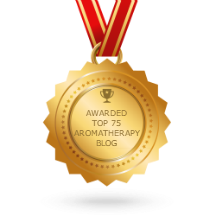Anyone following Mark Webb in the aroma
world, or talking to his previous students, have heard them mention “W A Sandalwood” AT LEAST once. For me, it has been the ultimate teaser, the
one
thing they still had in Australia that I hadn’t tried. But that is about to end, as Nature’s Gift
just received a shipment of this oil that Webb refers to as “a deliciously
sweet balsamic woody scent,” that he loves so much he uses it as his personal
scent. (1)
Santalum spicatum R. Br., Western Australian
Sandalwood, is a small evergreen tree.
The sapwood is pale, the heartwood dark brown. The oil is extracted from the heartwood and
rootball using solvent extraction and vacuum codistallation. (1)
So what
is the difference between this Australian Sandalwood and Sandalwood from other
sources? Webb states that if one were to
compare constituents of W A sandalwood with East Indian Sandalwood (S.album) –
both are extracted from the heartwood and rootball. They are chemically similar, both contain
alpha and beta santalol, that which provides the distinct “sandalwood”
scent. However, W A Sandalwood oil has
higher levels of farnesol and alpha-bisabolol than its East Indian
counterpart. Both have been shown to
have antimicrobial and anti-inflammatory properties. (1)
Comparative
Chemical Constituents of S. spicatum and S. album:
COMPOUND S.
spicatum S.
album
Pre-alpha-santalol compounds 9-10
alpha-santalol
21-28
50
alpha-bisabolol 4-5
-
z-alpha-bergamatol
5-6
3
beta-santalol 24-28
24
farnesol
4-7
-
bergamatol – like compounds 17-24
-
lanceol – like compounds 2-3
1
Steffen
Arctander, author of Perfume and Flavor
Materials of Natural Origin, described W A Sandalwood as “soft, woody,
extremely tenacious and somewhat balsamic in its delicate sweetness.” Webb explains that it is that top note that
is different from album oil, not as sweet, but a bit resinous like myrrh. (1)
 |
| Image Courtesy of The Paperbark Co. |
Curtin
University in Western Australia has done research into the historic use of
Western Australia sandalwood oil. Before
the use of penicillin became global in 1946, sandalwood was used in capsules
for urinary tract infections and gonorrhea.
Several experiments indicate the anti-microbial effectiveness of
Sandalwood. Some of this experiments
specifically cite W A Sandalwood, where as some do not specify which
species. In 1998, W A Sandalwood was
shown to be more effective against Candida albicans than Tea Tree. In 2000, W A Sandalwood showed to have an
inhibitory effect against the herpes simplex virus. (1)
Traditionally, the antimicrobial attributes have been accredited to the
farnesol content, a compound known in floral oils such as Ylang Ylang. Farnesol makes up 5-10% of the oil content in
W A Sandalwood oil. Promising research
indicates other effective uses of this constituent. In 2014, research
in São Paulo, Brazil found that Farnesol and geraniol could be promising
chemopreventive agents against
hepatocarcinogenesis. Obviously further
studies are required, but this is an exciting development. (2)
Santalum
spicatum is a known bacteriostat, shown able to hinder the growth of those
organisms causing acne and tinea (Stanzl., 1998). Further investigation of W A Sandalwood’s
effectiveness continues. (1)
Sydney
University research has shown that W A Sandalwood oil has anti-inflammatory
properties, supporting traditional use of the oil in this way. Alpha-bisabolol is accredited for the
anti-inflammatory properties of W A Sandalwood oil, ranging in content of 5-10%
of the constituent. In addition, the
content of beta-santalene, though normally below 1%, also has anti-inflammatory
properties. Research continues to
investigate other historical uses for this wonderful oil. (1)
The
Australian Therapeutic Goods Administration have authorized licensure for the
topical and inhaled use of W A Sandalwood.
(1)
Robert
Tisserand advices of a theoretical drug interaction between W A Sandalwood and drugs metabolized
by the enzyme CYP2D6. (3)
References:
(1)Mark
Webb. Bush Sense, Australian Essential Oils and Aromatic
Compounds, Adelaide, Australia: Griffin Press, 2000.
(2)http://www.researchgate.net/publication/7436350_Farnesol_and_geraniol_chemopreventive_activities_during_the_initial_phases_of_hepatocarcinogenesis_involve_similar_actions_on_cell_proliferation_and_DNA_damage_but_distinct_actions_on_apoptosis_plasma_cholesterol_and_HMGCoA_reductase._Carcinogenesis_271194
(3) Robert Tisserand/Rodney Young. Second Edition, Essential Oil Safety: Churchill Livingstone, 2013.
You may read more about, and order your own Australian Sandalwood here.
You may read more about, and order your own Australian Sandalwood here.



2 comments:
Have you sampled the S. album that grown in Australia and what is your thought on this matter? Thanks.
Sorry, no I haven't. Will ask Mark about it, and see if he has some he can share in Atlanta. However, since it isn't indigenous to Australia, I think we would do better with the oil from Tamil Nadu, where it IS a native tree.
Post a Comment